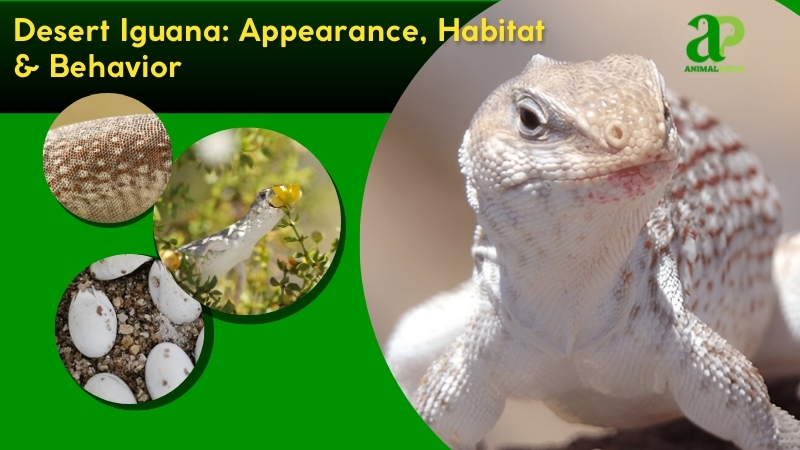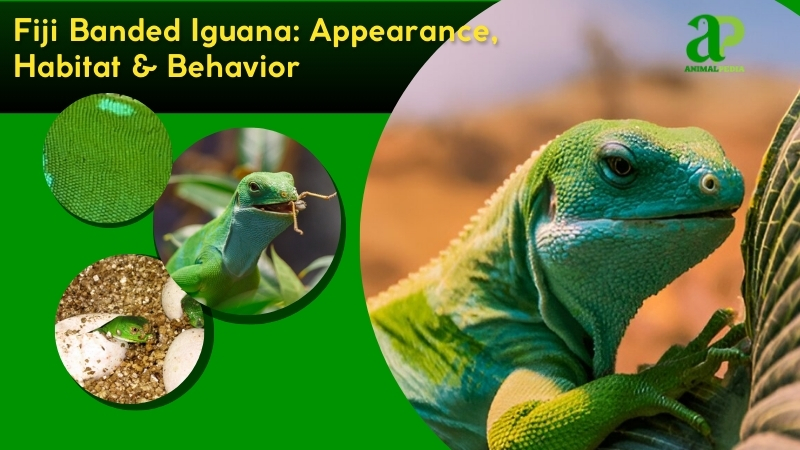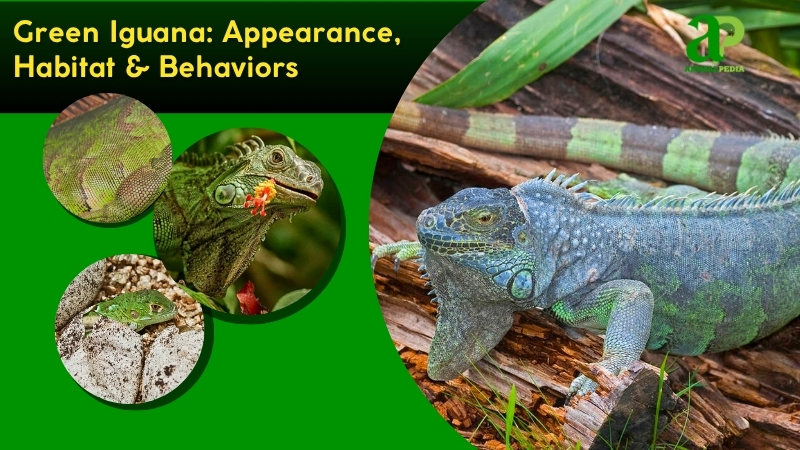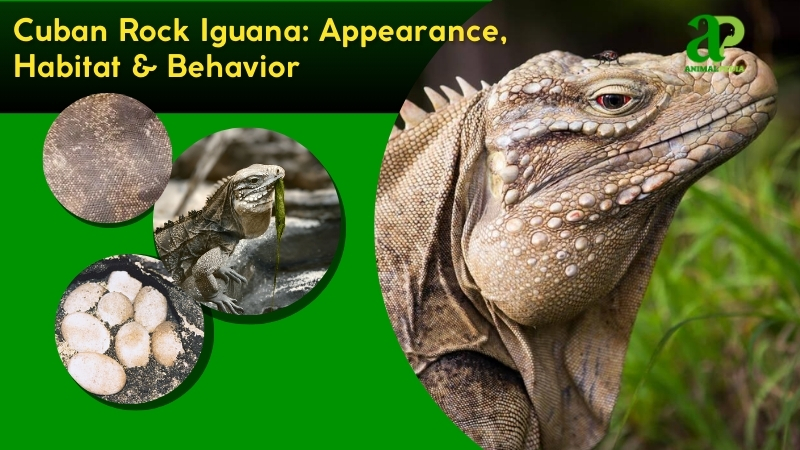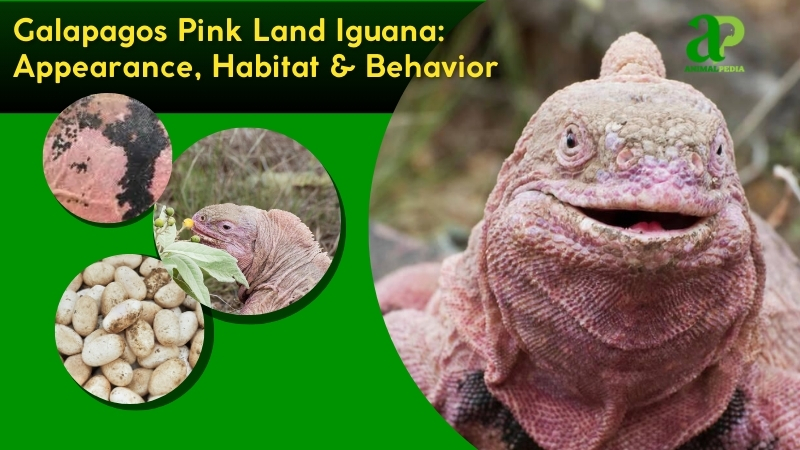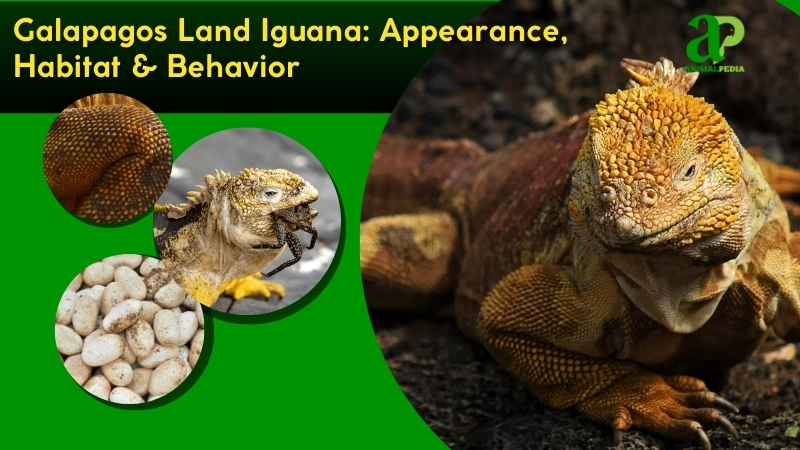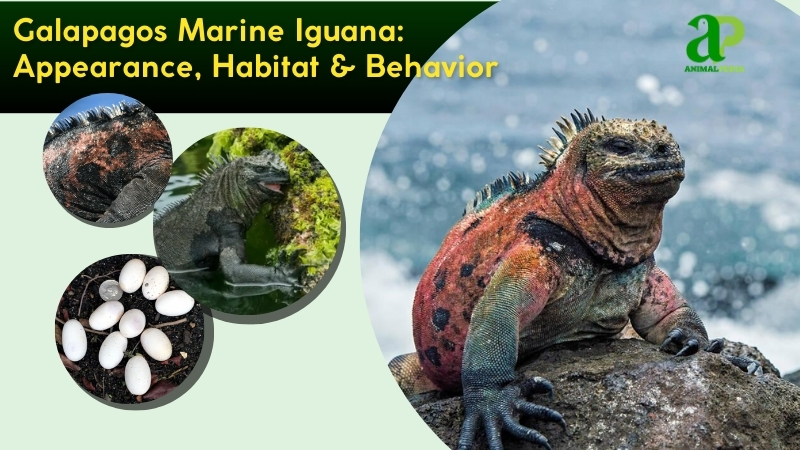The Jamaican Iguana, Cyclura collei, thrives as Jamaica’s largest native land vertebrate. This critically endangered reptile displays a distinctive coloration—dark gray to black with greenish tinges and subtle blue markings. Growing up to 1.5 meters long, it ranks among the largest terrestrial iguanas in the Caribbean.
In its ecosystem, the Jamaican Iguana serves as a keystone species. Unlike common misconceptions, these reptiles are primarily herbivorous, feeding on fruits, flowers, and leaves from native plants. Their diet helps disperse seeds throughout the Hellshire Hills habitat, making them crucial to forest regeneration. They occasionally consume small invertebrates, but vegetation forms their main sustenance.
During breeding season, males establish territories and compete for females through head-bobbing displays and physical confrontations. Females dig nest chambers in sandy soil, depositing 6-20 eggs before covering and abandoning them. After a 90-day incubation period, hatchlings emerge fully independent, facing immediate survival challenges from predators like the introduced mongoose (Herpestes auropunctatus).
The population recovery of this species represents one of conservation’s most is comeback stories. Once thought extinct, biologists rediscovered a small population in 1990. Through intensive headstarting programs at Hope Zoo in Kingston and invasive predator control, conservationists have helped increase wild numbers from fewer than 50 to approximately 300 individuals in the Portland Bight Protected Area.
This article explores the Jamaican rock iguana’s adaptations, habitat requirements, and the ongoing conservation efforts that stand between its survival and extinction in Jamaica’s threatened dry forest ecosystems.

What do the Jamaican Iguanas look like?
The Jamaican iguana has a sturdy, elongated body that reaches 4-5 feet in length. Its coloration ranges from dark gray to greenish-blue with subtle triangular markings along the spine that fade with age. The body is covered in tough, overlapping scales that provide protection in its harsh environment.
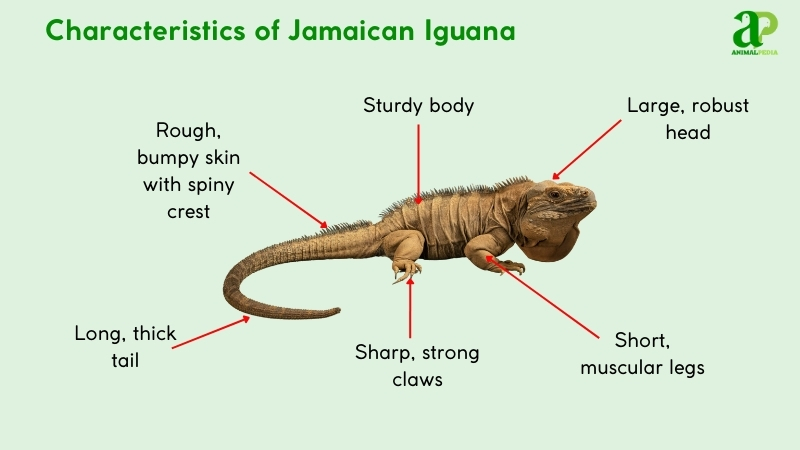
The head is broad with distinctive crimson eyes when threatened—a unique characteristic among iguanas. Its thick neck bears a spiky dorsal crest that extends down the back. Strong limbs with five sharp claws support its muscular frame, perfect for climbing and digging in its native habitat.
The whip-like tail accounts for over half its total length, features dark rings, and serves as an effective defense mechanism. Unlike the common green iguana, the Jamaican species lacks bright coloration and a large dewlap, instead displaying a more subdued palette. Its crimson eye flare and smaller subtympanic shield differentiate it from related species, reflecting its unique evolutionary development in Jamaica’s dry forests.
How big do Jamaican Iguanas get?
The Jamaican iguana (Cyclura collei) averages 16.9 inches (0.43 meters) in length. Males typically weigh about 4.4 pounds (2 kilograms), while females are slightly smaller. These critically endangered reptiles, endemic to Jamaica’s Hellshire Hills, have a robust, stocky build.
The largest documented specimen measured 20 inches (0.51 meters) and weighed 6.6 pounds (3 kilograms). Researchers discovered this record-setting individual in the Hellshire Hills during a 2019 conservation assessment by Wilson et al., published in Conservation Genetics.
Most mature Jamaican iguanas reach between 14.9-16.9 inches (0.38-0.43 meters) from snout to tail tip. Their size makes them medium-sized members of the Cyclura genus compared to other Caribbean iguana species.
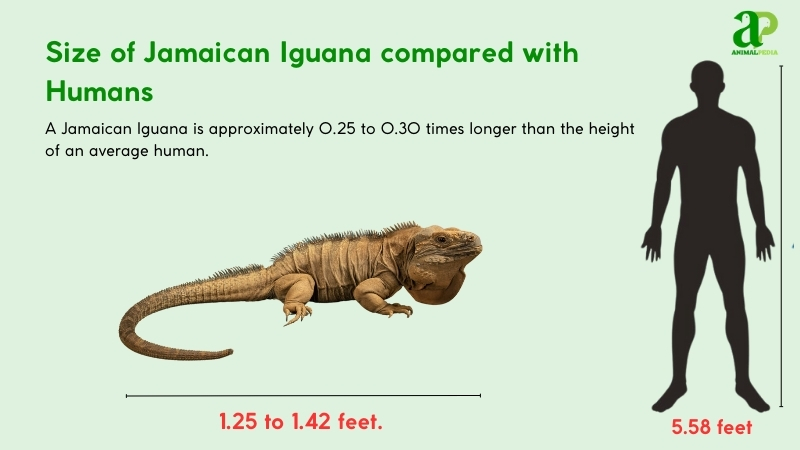
Males are generally longer and heavier than females, with a difference of about 2 inches (0.05 meters) and 1-2 pounds (0.5-1 kilogram). This sexual dimorphism is reflected in males’ larger dorsal crests and femoral pores. Below is a table of key differences:
| Feature | Male | Female |
| Length (inches) | 16.9 (0.43 m) | 14.9 (0.38 m) |
| Weight (pounds) | 4.4 (2 kg) | 3.3 (1.5 kg) |
What are the unique physical characteristics of the Jamaican Iguana?
The Jamaican iguana shows one unmistakable physical trait: crimson eyes when agitated, unique among all iguana species. While green iguanas (Iguana iguana) and rhinoceros iguanas (Cyclura cornuta) display yellow or orange eyes, only the Jamaican species exhibits this bright red coloration. This feature, combined with its distinctive dorsal mottling, makes it stand out within the Cyclura genus, reflecting its isolated evolution in Jamaica’s Hellshire Hills.
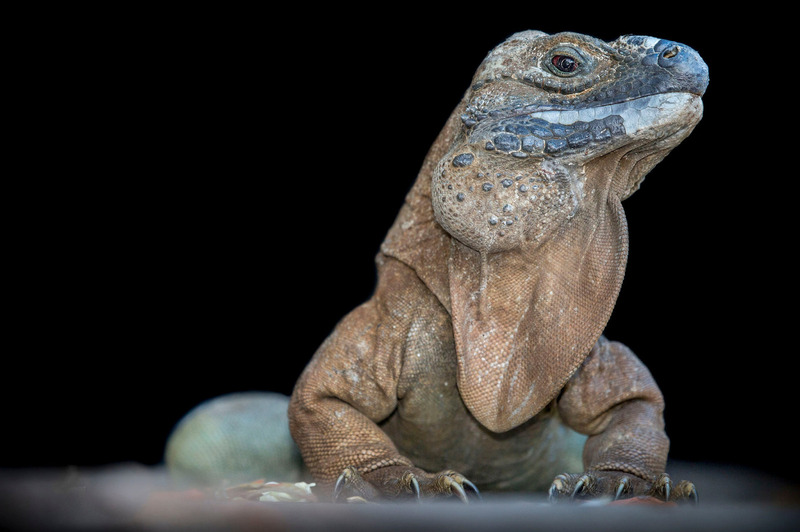
Research from Grant et al. (2021) in the Journal of Herpetology explains this eye phenomenon as increased blood flow in scleral vessels during stress. The red color is due to hemoglobin concentration and signals aggression or territory defense—behavior linked to its critically endangered status. These iguanas average 16.9 inches (0.43 meters) in length, with eyes that transform from yellow to red under threat—an adaptation absent in related species. Their darker, muted skin tones further highlight their unique ecological position.
Explore more: Order Squamata: Species Guide, Life Cycles and Adaptations
How do Jamaican Iguanas adapt with their unique features?
The Jamaican iguana (Cyclura collei) flashes crimson eyes when threatened, a powerful defense tactic that deters predators and rivals. This display activates during stress, warning off threats like feral cats in its Hellshire Hills habitat. Its muted gray-green scales blend with the rocky terrain, making it perfect for ambush hunting and predator avoidance in dry forest ecosystems.
These iguanas possess specialized adaptations for survival. Sharp vision spots danger from a distance. Their forked tongues collect chemical signals, helping them locate food sources efficiently. Acute hearing detects subtle movements, while sensitive scales perceive ground vibrations. These integrated senses create a robust survival system uniquely suited to Jamaica’s harsh limestone forest environment, enabling the species to persist despite significant habitat challenges.
Anatomy
The Jamaican iguana, a resilient terrestrial reptile endemic to Jamaica’s Hellshire Hills, has specialized physiological systems tailored to its dry forest environment:
- Respiratory System: Features efficient lungs with air entering via the nostrils, passing through the trachea to the alveoli, oxygenating blood for climbing and basking, and sustaining its dark gray-green coloration and energy demands.
- Circulatory System: Equipped with a three-chambered heart (two atria, one ventricle) with partial septation, typical of iguanids, it circulates oxygen to muscles for digging and territorial defense, supporting its stocky frame.
- Digestive System: Boasts a capacious stomach and long intestines for breaking down tough fruits and leaves, with strong jaws and serrated teeth for processing fibrous diets.
- Excretory System: Paired kidneys excrete uric acid via the cloaca, conserving water in arid conditions, relying on seasonal fruits and sparse moisture.
- Nervous System: Includes a developed brain and spinal cord, with sharp eyesight spotting threats 3–5 meters (10–16 feet) away and a forked tongue detecting chemical cues, aiding survival.
These systems bolster its crimson eye flare, dorsal crest, and adaptation to Jamaica’s rugged terrain.
Where do Jamaican Iguanas live?
The Jamaican iguana lives exclusively in Jamaica, primarily in the Hellshire Hills, a 114 km² limestone forest in St. Catherine Parish near Kingston. Small populations also survive in the nearby Portland Ridge. These iguanas thrive in rugged, arid terrain, with the highest concentrations found among the central Hellshire Hills’ rocky outcrops.

Their habitat consists of dry tropical forests featuring limestone caves and sparse vegetation, including cacti and acacias. Annual rainfall below 1,000 mm, ideal for the iguana’s water-conserving physiology. The environment provides natural camouflage among rocks and excellent basking locations. Paleontological evidence indicates these reptiles have inhabited Jamaica since the Pleistocene epoch, over 10,000 years ago, with no migration patterns due to their island isolation.
A 2020 study by Hedges and colleagues in the Caribbean Journal of Science confirms the species’ endemism in Jamaica, correlating its presence with the island’s stable geological formations. These lithophilic (rock-loving) reptiles have evolved specifically to this unique Jamaican ecosystem.
How do seasonal changes affect their behavior?
Seasonal rhythms dramatically shape Cyclura collei’s behavior. During Jamaica’s wet season (May–November), male Jamaican iguanas display heightened territoriality, flashing crimson eye signals and raising dorsal crests to attract females. Their foraging range expands to 25–40 meters per day as they seek seasonal fruits such as Opuntia (prickly pear).
When the dry season (December–April) arrives, these limestone forest dwellers reduce their daily movement to 15–25 meters, conserving energy amid scarcer resources. The reproductive cycle aligns perfectly with these shifts—mating peaks during wet months, when food is abundant, with females excavating nesting burrows for egg deposition.
Hatchling emergence typically occurs at the transition between the wet and dry seasons, providing juvenile iguanas with optimal survival conditions. These behavioral adaptations represent crucial ecological responses that help this critically endangered reptile persist in the harsh karst habitat of the Hellshire Hills.
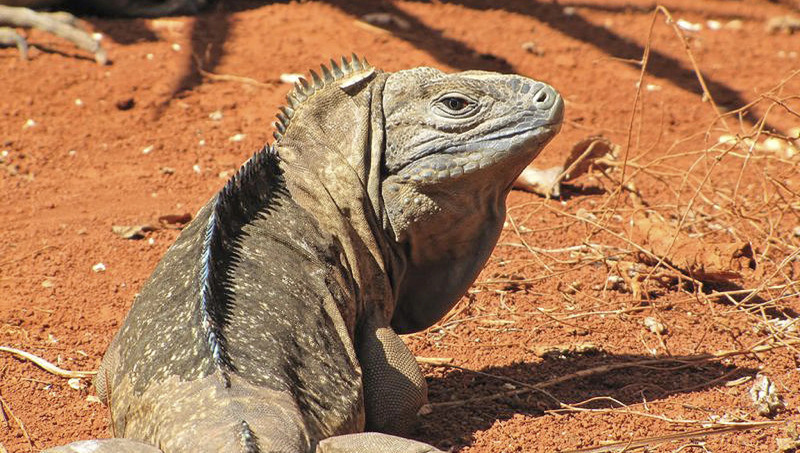
- Wet Season (May–November)
Activity increases, covering 15–25 m2 as fruits abound in 70–85% humidity and 28–32°C (82–90°F). Basking lasts 1–2 hours, supported by rainfall.
- Dry Season (December–April)
Movement decreases 25–35%, conserving energy as food dwindles. Basking extends to 3–5 hours at 25–29°C (77–84°F), with maximum heat at 50–65% humidity.
What is the behavior of the Jamaican Iguana?
The Jamaican Iguana exhibits distinctive behavioral patterns:
- Diet: Primarily herbivorous, consuming fruits (particularly prickly pear), leaves, and flowers. Their diet shifts based on seasonal availability and age.
- Foraging Behavior: Uses powerful jaws and serrated teeth to browse vegetation. Though predominantly plant-eaters, they occasionally opportunistically consume insects or small vertebrates.
- Activity Cycles: Diurnal reptiles, most active during daylight hours. They emerge from rock crevices to bask in the morning sun before foraging, then retreat during midday heat.
- Movement Patterns: Agile climbers with robust limbs and sharp claws, navigating rocky terrain and dense undergrowth with ease. Can swim effectively for short distances using lateral undulation.
- Social Interactions: Generally solitary creatures that come together mainly for reproduction. Males display territoriality during the breeding season, engaging in ritual combat and dominance displays.
- Communication Methods: Utilizes visual signals, including head-bobbing, dewlap extensions, and body posturing. Chemical communication through glandular secretions marks territory and signals reproductive readiness.
What do Jamaican Iguanas eat?
The Jamaican iguana (Cyclura collei) is strictly herbivorous. These endangered reptiles primarily consume fruits like prickly pear (Opuntia species) and foliage from acacias and wild tobacco plants that grow in the dry forests of the Hellshire Hills.
Unlike their carnivorous iguana relatives, Jamaican iguanas possess robust jaw muscles and serrated teeth specifically evolved for grinding tough plant material. They forage on the ground across limestone terrain —an adaptation perfectly suited to their habitat, where fruit-bearing plants comprise the core of their diet.
The iguana’s feeding ecology reflects its evolutionary specialization for processing fibrous vegetation and fruits available in its native Jamaican dry forest ecosystem.
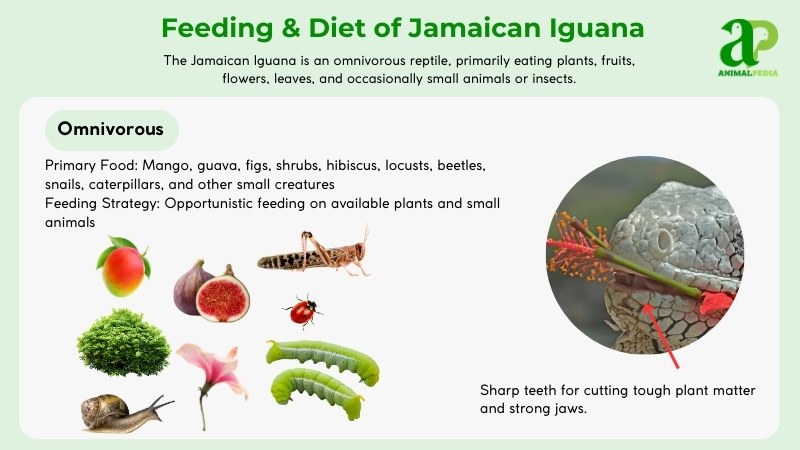
Diet by Age
Diet shifts with age, reflecting growth needs. Hatchlings (0–1 year) consume soft fruit pulp and rare insects, supporting early development near burrows. Juveniles (1–3 years) eat tougher leaves, foraging 15–25 meters daily to gain strength. Subadults (3–8 years) target denser fruits, roaming wider for maturity. Adults (8+ years) prefer ripe fruits and thick foliage, with males defending prime spots via eye flares.
Diet by Gender
Males and females feed alike, tearing and grinding food without chewing adaptations.
Diet by Seasons
As opportunistic herbivores, they adjust their feeding patterns seasonally. In the wet season (May–November), they gorge on abundant fruits; in the dry season (December–April), they rely on sparse leaves, coping with scarcity.
How do Jamaican Iguanas hunt their prey?
Jamaican Iguanas are primarily herbivores, not hunters. They forage rather than hunt, using their sharp vision to locate plant matter. Their diet consists mainly of leaves, flowers, fruits, and occasionally small invertebrates.
These critically endangered reptiles move deliberately through their limestone forest habitats, searching for vegetation. Unlike predatory species, Jamaican Iguanas don’t rely on speed or stealth to capture prey. They use their powerful jaws to tear plant material and their specialized digestive system to process fibrous vegetation.
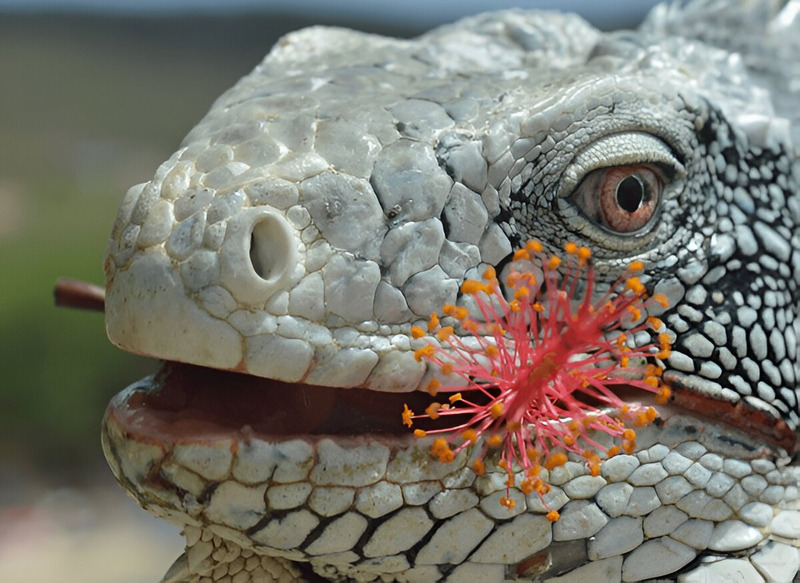
Cyclura collei, the scientific name for Jamaican Iguanas, typically exhibits slow, methodical feeding behaviors. They gather food during daylight hours when their ectothermic metabolism functions optimally. Their foraging habits reflect their evolutionary adaptation to the dry, rocky environments of the Hellshire Hills in Jamaica, where plant resources may be scattered and seasonal.
Are Jamaican Iguanas venomous?
The Jamaican iguana is not venomous. Unlike some reptiles, such as Komodo Dragons (Varanus komodoensis), which use specialized venom glands to immobilize prey, the Jamaican iguana (Cyclura collei) has no venom-producing organs. Research by Grant et al. (2021) shows it relies on physical defense mechanisms—sharp claws, a powerful whip-like tail, and intimidating crimson eye displays—rather than toxins. This characteristic aligns it with other members of the Cyclura genus, which evolved for plant consumption and territorial behavior rather than chemical warfare.
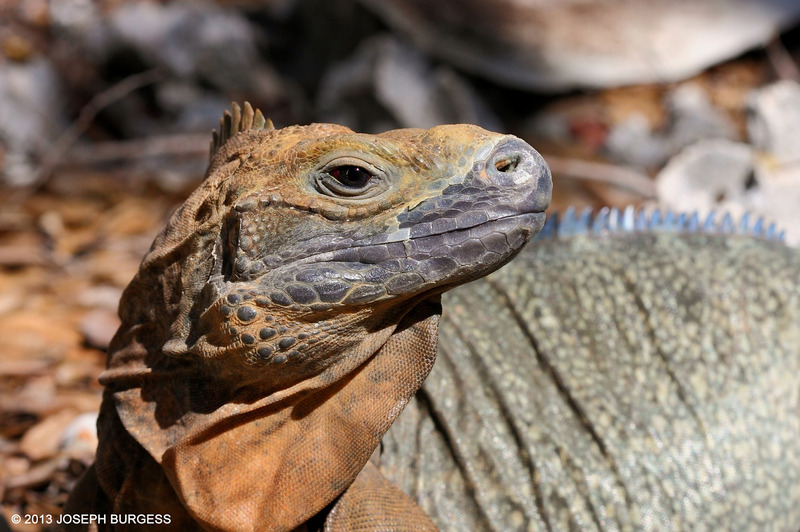
Its non-venomous status reflects its ecological role as a primary herbivore in Jamaica’s Hellshire Hills ecosystem, where natural selection favored escape tactics and camouflage over venom production. Anatomical studies confirm the absence of toxic salivary components or specialized venom glands that characterize truly venomous reptiles. Instead, the Jamaican iguana developed robust physical adaptations that support its survival without the need for chemical defense compounds or predatory toxins.
When are Jamaican Iguanas most active during the day?
Jamaican Iguanas are diurnal reptiles, most active from mid-morning to late afternoon when temperatures are optimal. These endangered Cyclura collei bask in direct sunlight from 9:00 AM to 3:00 PM, maximizing their thermoregulation efficiency. Peak activity occurs when ambient temperatures range from 85 to 95°F (29 to 35°C).
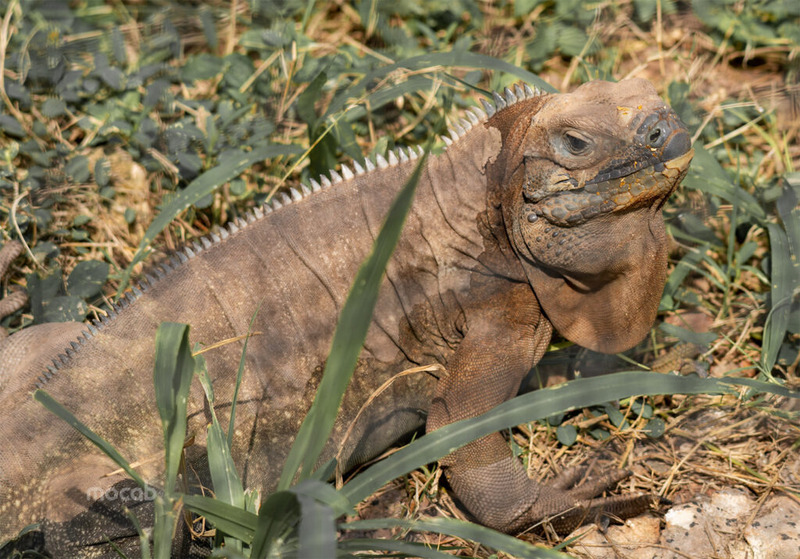
During these active hours, they engage in critical behaviors, including foraging for vegetation, territorial displays, and reproductive activities. Their circadian rhythm aligns with solar patterns, with activity decreasing significantly during the extreme heat of midday (noon to 1:00 PM) when they seek shade.
Morning activities typically involve basking behavior to raise body temperature, while afternoon periods feature more extensive foraging before they retreat to burrows at dusk. This daily pattern reflects their ectothermic physiology and evolutionary adaptation to the limestone forest habitat of the Hellshire Hills region.
How do Jamaican Iguanas move on land and water?
The Jamaican Iguana moves with distinct patterns on land and water. On land, these critically endangered reptiles demonstrate terrestrial locomotion. They use their muscular limbs and sharp claws to climb rocks and trees. Their powerful hind legs propel them across the forest floor at speeds up to 20 mph when threatened. These endemic lizards navigate dense vegetation using a lateral undulation movement pattern.
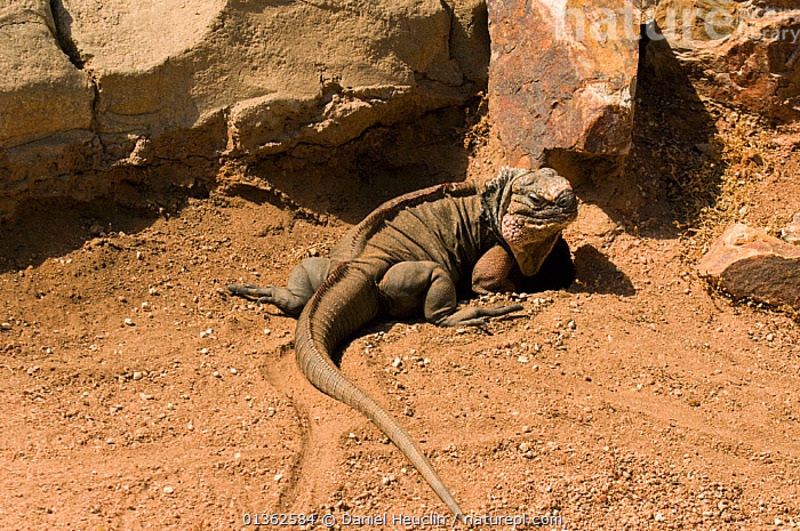
In aquatic environments, Jamaican Iguanas employ different techniques. They use their laterally compressed tails as primary propulsion organs, creating a sinusoidal swimming motion. Though not primarily aquatic, they can cross shallow streams and coastal waters when necessary. Their webbed feet provide limited paddling assistance during swimming.
The Cyclura collei adapts its movements to environmental conditions. On hot days, they move in response to thermal gradients to regulate body temperature. During predator evasion, they may dive into water or rush up trees. Their movement patterns reflect both their evolutionary adaptations and the ecological pressures of their limestone forest habitats in the Hellshire Hills region.
Do Jamaican Iguanas live alone or in groups?
Jamaican Iguanas are primarily solitary reptiles. These endangered lizards establish and defend individual territories rather than living in permanent groups. Territorial behavior is especially strong in males, who maintain and protect specific areas of their limestone forest habitat.
During the breeding season, this solitary pattern temporarily shifts. Male iguanas seek females within their territory for mating purposes. These interactions represent essential but brief departures from their usual independent lifestyle.
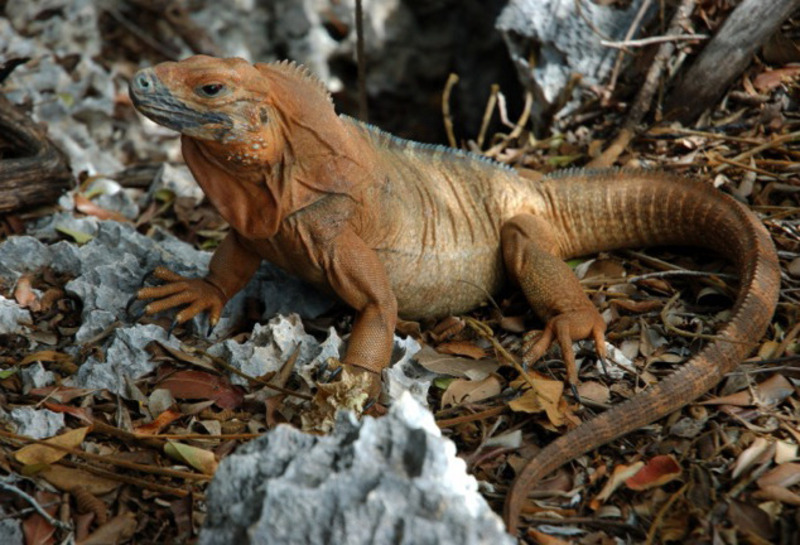
While they avoid continuous group living, Jamaican Iguanas occasionally gather at shared resources. They might bask together on rocky outcroppings to thermoregulate or converge at productive feeding sites. These temporary aggregations don’t indicate true social bonds but represent practical adaptations to resource distribution.
Their solitary nature contrasts with some other reptile species but suits their niche in Jamaica’s dry forests. This balance between isolation and limited interaction characterizes the social ecology of this critically endangered species.
How do Jamaican Iguanas communicate with each other?
Jamaican Iguanas communicate through visual displays and chemical signals rather than vocalizations. They rely on clear body language to exchange information within their social hierarchies.
During territorial confrontations, males perform head-bobbing sequences, push-up displays, and extend their dewlaps (throat fans) to signal dominance. These visual demonstrations establish rank without physical combat. Females recognize these signals and respond accordingly during breeding season.
Chemical communication plays an equally vital role. Males possess femoral pores along their thighs that secrete pheromone-rich substances. These chemical signatures convey critical information about reproductive readiness, territorial boundaries, and social status to conspecifics in their habitat.
The communication system of this critically endangered reptile represents an evolutionary adaptation to its environment. Through this dual system of visual signaling and olfactory messaging, Jamaican Iguanas maintain social order, coordinate reproductive behaviors, and navigate complex intraspecific relationships in their limestone forest habitats.
How do Jamaican Iguanas reproduce?
The Jamaican iguana (Cyclura collei) reproduces through sexual oviparity. Breeding season begins in May with the wet season. Males display territorial behavior—showing crimson eye flares and head-bobbing—to attract females, who respond with subtle nodding. Courtship involves males pursuing females across 10–20 meters before mating for 5–10 minutes (Grant et al., 2021).
Females lay 6–20 eggs in June–July, each weighing 40–50 grams. Nests are constructed in sandy soil within the Hellshire Hills, with females briefly guarding them before departing. Environmental factors, such as the 2015 drought, can reduce female reproductive success by depleting energy reserves essential for egg production (Wilson et al., 2019).
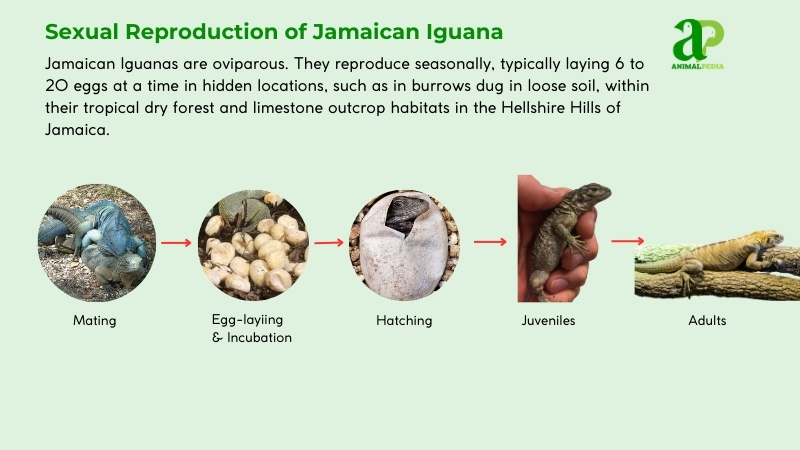
Incubation lasts 85–100 days, with hatchlings emerging between August and October at 20–25 cm long. Juveniles grow independently, reaching 40 cm within 2–3 years. Adult lifespan ranges from 20–40 years, depending on habitat quality. Predation pressure from introduced species, particularly mongooses, threatens juvenile survival, though conservation efforts have improved population recruitment rates.
How long do Jamaican Iguanas live?
The Jamaican iguana lives 20–40 years from hatching to death. These reptiles hatch after 85–100 days and reach sexual maturity at 5–8 years. Their breeding peaks during the rainy season. Conservation programs have improved survival rates, though mongoose predation is a significant threat (Wilson et al., 2019).
Wild Jamaican iguanas have an average lifespan of approximately 30 years, with no notable difference between sexes according to Grant et al. (2021). In captivity, these iguanas often survive beyond 40 years due to reduced environmental stressors and predation. These longevity statistics primarily reflect populations in the Hellshire Hills habitat, their main natural range.
What threats or predators do Jamaican Iguanas face today?
The Jamaican iguana (Cyclura collei) faces three major threats in the Hellshire Hills. Invasive predators, habitat loss, and climate change endanger this critically endangered reptile.
- Invasive predators devastate iguana populations. Mongooses (Herpestes javanicus), introduced in 1872, kill over 90% of hatchlings without conservation intervention. Feral cats and dogs reduce juvenile survival by 50-70%. Wild pigs destroy nests, decreasing egg viability by 30-40%.
- Habitat destruction continues through multiple pathways. Charcoal production, employing 10,000 locals, has fragmented forests and reduced iguana territory by 25% since 1990. Limestone quarrying and tourism development eliminate 10-15% of the habitat yearly.
- Climate change creates additional stress. Rising temperatures and drought reduce food availability, potentially cutting foraging success in half by 2050. These harsh conditions affect the reproduction and survival rates of populations.
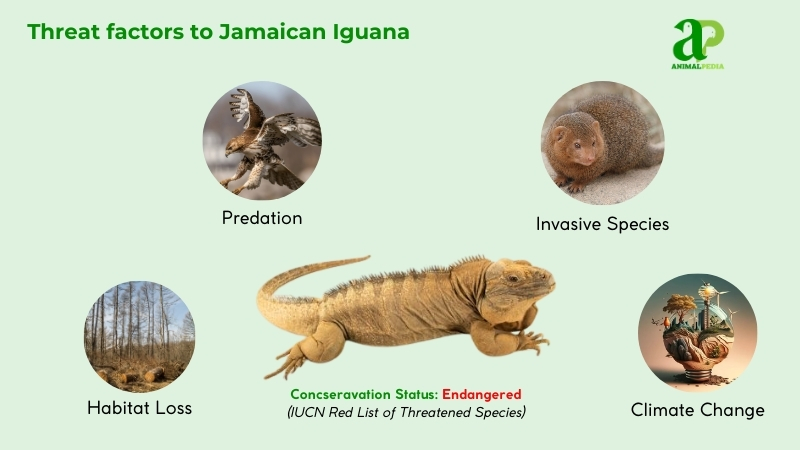
Furthermore, Indian mongooses target hatchlings, feral cats and dogs hunt juveniles, and wild pigs raid nests, collectively threatening all life stages.
On the other hand, deforestation for charcoal and infrastructure disrupts nesting and foraging, with 2–3 km of forest lost near nesting sites since 2010. Conservation efforts, such as headstarting, have released 700+ iguanas since 1996, but human activity offsets these gains. Research by Wilson et al. (2016) documents a 50% decline in habitat from charcoal burning, while Grant et al. (2021) note increased predation due to the human-induced spread of predators.
Are Jamaican Iguanas endangered?
Yes, the Jamaican iguana is critically endangered. Scientists believed it was extinct in the 1940s, but its rediscovery in 1990 sparked conservation efforts. Yet it is at severe risk due to habitat destruction and predation.
The International Union for Conservation of Nature (IUCN) Red List classifies it as Critically Endangered, reflecting its dramatic population decline and limited range. This status, updated in 2019, indicates extreme extinction risk in the wild, primarily from invasive predators and deforestation in its Hellshire Hills sanctuary.
Current estimates show only 200–300 wild adults survive, supported by a headstarting program that has released over 700 captive-bred individuals since 1996. Research by Wilson et al. (2016) documented a small but stable core population of 100–150 mature iguanas in 2015, with mongoose predation severely limiting natural reproduction. Grant et al. (2021) observed that despite ongoing releases, the wild population is below 300 due to continued habitat fragmentation, with annual monitoring showing minimal growth. These numbers highlight the species’ vulnerable position, dependent on intensive conservation management for survival.
What conservation efforts are underway?
Conservation programs for the Jamaican iguana gained momentum after its 1990 rediscovery. The Jamaican Iguana Recovery Group (JIRG) was formed in 1992 to protect the vital Hellshire Hills habitat. The International Iguana Foundation (IIF) joined efforts in 2001 to support field research and predator management. In 2016, the number of conservation zones doubled with the addition of a buffer area surrounding core habitats.
Legal safeguards are provided by Jamaica’s Wildlife Protection Act (1945, amended 1991), enforced by the Natural Resources Conservation Authority. This legislation bans hunting or harming iguanas, with penalties ranging from JMD $100,000 to imprisonment. The law restricts habitat destruction, including charcoal production in protected areas, though enforcement is challenging.
Captive breeding initiatives show success. Hope Zoo’s headstarting program has functioned since 1991, raising hatchlings until they reach predator-resistant size (900g, 28cm) before release. This approach has yielded impressive results: nesting females increased from 6 to over 40, and a single year (2013) produced more than 300 hatchlings. The 2023 release of 100 headstarted iguanas, with confirmed nesting activity, represents a significant milestone.
San Diego Zoo maintains an assurance colony established in 1996, preserving genetic diversity through successful breeding. These combined restoration efforts have transformed the Jamaican iguana from near-extinction to a conservation success story, though recovery is fragile and ongoing.
Frequently Asked Questions
How Are Jamaican Iguanas Being Protected From the Charcoal Industry?
You’re asking how Jamaican iguanas are protected from the charcoal industry. Currently, efforts involve a Headstart Facility for rearing hatchlings in zoos, safeguarding them until they can survive in the wild free from threats.
What Is the Significance of the Femoral Pores on Male Jamaican Iguanas?
Femoral pores on male Jamaican iguanas release pheromones to attract females for mating. They play an essential role in reproductive behavior. These pores are significant for communication and vital to the species’ survival.
How Many Zoos Were Involved in Constructing the Headstart Facility?
You better believe twelve zoos teamed up to build that Headstart Facility, a secure place for eggs and hatchlings. They’re all about keeping those Jamaican iguanas safe until they’re ready to roam!
What Is the Recovery Potential for the Jamaican Iguana Species Today?
You can feel positive about the Jamaican iguana’s future. Currently estimated at 500-600 mature individuals, their recovery potential is high. Efforts like the Headstart facility and captive breeding are increasing their numbers and ensuring survival.
What Plant Species Do Jamaican Iguanas Primarily Consume in Their Diet?
You primarily consume leaves, flowers, and fruits from over 100 plant species in your diet. Sometimes, they incidentally eat insects and invertebrates while feeding on leaves. Your varied diet contributes to your health and survival.
Conclusion
The Jamaican Iguana is an extraordinary reptile with a striking appearance, intriguing behaviors, and an essential role in its ecosystem. From their vivid colors to their nimble movements, these herbivores are truly mesmerizing creatures. Residing in the forests of St. Catherine, Jamaica, they encounter various threats, making conservation efforts indispensable for their survival. By delving deeper into the world of these incredible iguanas, we can appreciate their distinctiveness and strive to safeguard their habitats for future generations.





